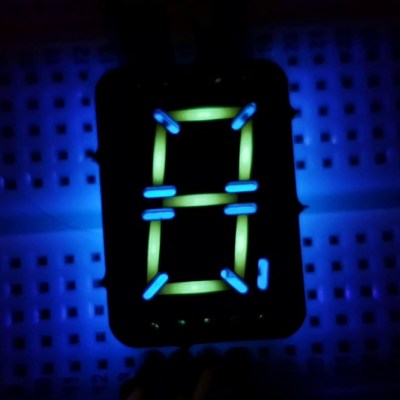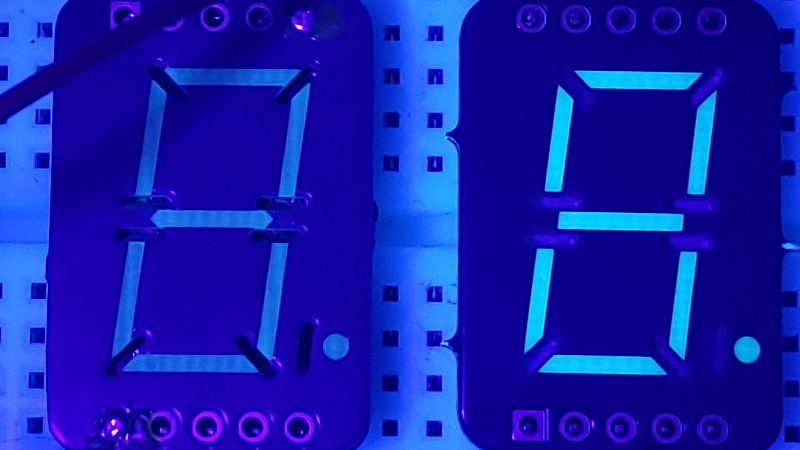It’s interesting what you see when you train a black light on everyday objects. We strongly suggest not doing this in a hotel room, but if you shine UV light on, say, a printed circuit board, you might see what [Sam Ettinger] did, which led him to build these cool low-profile seven-segment fluorescent PCB displays.
 As it turns out, at least some FR-4 PCBs fluoresce under UV light, giving off a ghostly blue-green glow. Seeing the possibilities, [Sam] designed a PCB with cutouts in the copper and solder mask in the shape of a traditional seven-segment display. The backside of the PCB has pads for UV LEDs and current-limiting resistors, which shine through the board and induce the segments to glow. Through-slots between the segments keep light from one segment from bleeding over into the next; while [Sam] left the slots unfilled, they could easily be filled with solder. The fluorescent property of FR-4, and therefore the brightness and tint of the segments, seems to vary by board thickness and PCB manufacturer, but it looks like most PCBs will show pretty good results.
As it turns out, at least some FR-4 PCBs fluoresce under UV light, giving off a ghostly blue-green glow. Seeing the possibilities, [Sam] designed a PCB with cutouts in the copper and solder mask in the shape of a traditional seven-segment display. The backside of the PCB has pads for UV LEDs and current-limiting resistors, which shine through the board and induce the segments to glow. Through-slots between the segments keep light from one segment from bleeding over into the next; while [Sam] left the slots unfilled, they could easily be filled with solder. The fluorescent property of FR-4, and therefore the brightness and tint of the segments, seems to vary by board thickness and PCB manufacturer, but it looks like most PCBs will show pretty good results.
We’d say the obvious first improvement might be to cover the back of the display with black epoxy, to keep stray light down, and to improve contrast. But they look pretty great just as they are. We can also see how displays with other shapes, like icons and simple symbols. Or maybe even alphanumeric characters — say, haven’t we seen something like that before?















Well this certainly creates some interesting possibilities for making low-cost displays. I would be really interested to see how this works out when used on some of those high-end PCBs that can embed small components between layers.
If you don’t have black hot glue in your metaphorical holster, well, you’re welcome.
Lovely idea/design, but how much UV light passes through, directly into the viewer’s eyes? https://pubmed.ncbi.nlm.nih.gov/21617534/
You are joking right?
The PCB? You should assume all of it. Any blocking is entirely a “side effect” of the materials electrical and fire retarding properties.
The LEDs? Depends entirely on the LED you choose. The last ones I used were 380nm and about 0.2w, o about two thousandths of the UV-A that a 100w incandescent light bulb emits.
There is no parts listing for this projects LED to know how much enters their eyes specifically (but seeing as you’re using a computer monitor, that’s technically zero UV from them entering our eyes)
Very funny. These UV LEDs output half a bee’s dick to start with and the effective power is subject to the inverse square law, it drops by the square of the distance. So unless you’re shoving your eye against the PCB I think you’re safe.
Is it the resin that fluorescesses?
Sam’s conjecture is that the bisphenol-A (BPA) in the resin is what’s fluorescing. I found a paper on detecting BPA in toys using HPLC, with fluorescent detection (275 nm excitation, 313 nm emission), so it could be.
https://resources.perkinelmer.com/lab-solutions/resources/docs/APP_Analysis-of-Bisphenol-A-in-Toys-012153_01.pdf
Wonder what would happen if someone put some expired EL phosphor in there?
I tested it and it glows like a neon sign under UV, with a nice persistence effect to boot.
Looks like a cool idea for adding a custom glowing logo to your board
Cue DSKY replica using this technique in 3..2..1…